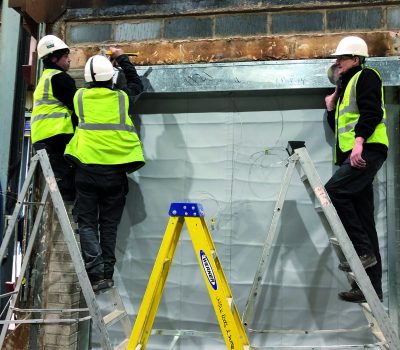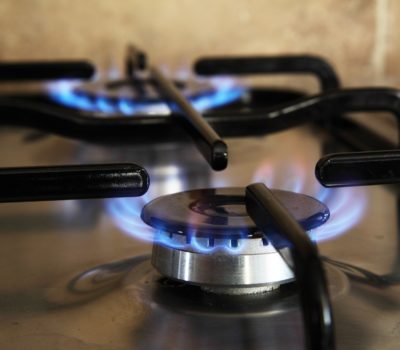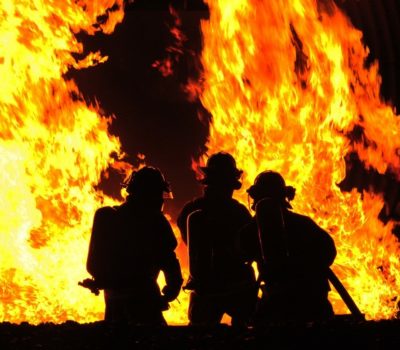Fire Safety in Kitchens
Essential fire safety information for kitchens at home and work. How you can identify fire hazards and risk and keep your kitchen and appliances safe from fire.
Anybody who’s accidentally left food under the grill a little too long or inadvertently flambéed their dinner will be well aware of the dangers of fire in the kitchen. In the last year, just under half of all fires which started in the home and required the attention of emergency services were traced back to cooking appliances.
Subsequently fire safety in kitchens is paramount when it comes to protecting our homes and workplaces from avoidable damage. The presence of gas and electric cooking appliances, cupboards full of food and combustible materials – as well as cooking oils and cleaning products – provides fire with the fuel it needs to destroy entire buildings, once ignited.
With so many small electrical appliances now also predominant in the modern kitchen, the potential for misuse of – and malfunctioning – equipment also contributes to many accidental fires. When combined with a haphazardly-placed tea towel, or build-up of fat and food around the stove, there exist a multitude of fire hazards in just this one small space of any building.
Thankfully, however, kitchens are also usually small spaces, and simple to make and keep safer from fire. Including ensuring that the right equipment is in place for responding to an incident and that the room itself is properly maintained, there are steps anybody who uses the kitchen can take to ensure they avoid coming to harm.
Firstly, you need a fire detection system in place and to make sure it is regularly tested. In the home, this would be a case of choosing the right alarm for your needs – and, below, we provide more detail on this point.
In the workplace, your smoke detector or fire alarm is likely to be part of a wider connected system linked to other areas of the premises. However, if the kitchen is your workplace, it could be connected to an even bigger network of safety measures.
Restaurant kitchens are high-risk areas full of flames, heat, fuel and sources of ignition. Suitably, therefore, they are often equipped with an automatic fire suppression system. This will responsively disperse chemicals to suppress cooking fires and shut down the fuel or electric supply to other equipment when activated. Although automated in this instance, this process of recognising and responding to fire is also a relevant safety tip suitable in any kitchen.
If you do encounter a fire in the kitchen, removing the source of the ignition – only if safe to do so – is the first step to take. Turning off stoves, ovens or any electrical equipment as quickly as possible could stop the fire spreading. Here, our own alertness to danger is as close to an ‘automatic fire suppression system’ as we are likely to have in the home.
Of course, how quickly we can react depends on how close we are to the fire. Never leave live flames or pans over a heat source unattended, even just to answer the phone or door. If you have to leave your kitchen while cooking, removing pans from the heat or turning them off entirely reduces the chance of any accident occurring.
While cooking, make sure that pan handles don’t stick out over live heat or other pans, or away from the stove itself. Keep electrical wires and other equipment away from the hobs, and take care not to let any fabrics – your own clothes included – get too close to the heat. Ensure that your cooking surfaces are kept clean, you remove burnt food and fat from cookers, hobs and grills, and any kitchen ventilation system is working to remove grease and other irritants from the air.
Not only in restaurants but any workplace kitchens, regular, thorough, fire safety risk assessments must be performed. Shared kitchens constantly full of busy people can quickly become hazardous environments without proper cleaning and preventative maintenance performed on the facility.
Staff need to be aware of existing hazards and the additional hazards they can create as they take their breaks. They also need to know what equipment is available to deal with a fire, how it is used or who is trained to use it, and standard evacuation procedures in case of an emergency. Most businesses will employ some level of cleaning service, but encouraging staff to keep their workplace kitchens clean and tidy can cut down on fire risks through every lunch break.
While a kitchen may certainly be an environment everyone is used to, it doesn’t mean that everyone will use it in the same, safe way. Younger employees, or interns, for instance, might not yet be up to speed on how to properly maintain a kitchen. Beware of toasters near curtains or blinds, overflowing kettles boiling the brews of an entire workforce and single wall sockets simultaneously dealing with smoothies, steamers, and smartphones.
Naturally, all of the above applies to the home, too – but, if you have small children, you may also want to consider oven and cooker guards in the kitchen. Most schools teach some form of home fire safety to students while they are young, so there does exist the chance that your child might be better at sniffing out a hazard in the kitchen than you are!
However, as long as this information ensures you don’t sniff out a fire in the home or workplace kitchen any time soon, we’ll be happy. Below are some regularly asked questions relating to fire safety in the kitchen, expanding on what we’ve covered above.
Smoke alarm or heat alarm?
While a smoke alarm would certainly work in the kitchen, it could work too well. Unless your dietary needs are met solely by microwave cooking and breakfast cereals, it’s likely you will regularly produce a range of zestful, smoky and steamy aromas, with the intention of igniting only the taste buds.
A smoke alarm positioned too close to your stove or oven will probably take note of your seared steaks, singed toast or steamed vegetables and regularly remind you that you’re cooking. When placing a smoke alarm in or around the kitchen, make sure it’s got a hush button, so you can acknowledge the alarm and continue preparing your food.
While it’s recommended to have at least one smoke alarm on any floor of a building, regardless, a heat alarm might be more appropriate for the kitchen. Detecting significant elevations in room temperature, the heat alarm will be more likely to alert you in the event of a fire, as opposed to a gently simmering soup.
Like standard smoke alarms, they are available in DIY stores for a reasonable price, don’t require an electrician to fit one and are usually battery-powered. Given the same regular maintenance as any other device, they provide peace of mind and are also kinder to your ears during your daily dinner preparation.
Other electrical equipment in the kitchen
It isn’t just the alarms that need regular maintenance, however. Within the kitchen, there are many other electrical devices, like fridge freezers, also designed to be left on 24/7. Others, like washing machines, tumble dryers and dishwashers, aren’t actually made to be on overnight or left running while you are out of the home. Registering appliances with the manufacturer as soon as they are purchased and taking note of warranty periods and scheduled services is essential to keeping the rest of the kitchen safe.
With smaller appliances, from blenders to espresso machines, be sure not to overload wall sockets, and remember to turn them off whenever you’re not in the room. While the main source of heat is likely to come from a stove or oven, any electrical appliance has the potential to malfunction and cause a problem.
Keep all your appliances clean at all times. Whether it’s on the inside of a microwave or at the bottom of a toaster, a build-up of grease, fat or food can damage any electrical appliance and create fuel for fires to burn. As we’ve already discussed, this also applies to ventilation systems, especially if you have a gas stove.
These aren’t just fire safety essentials, either. They’ll also stop your kitchen, home and workplaces carrying the unpleasant scent of old food and make sure that today’s dinner doesn’t taste like last week’s lunch.
How to use a deep fat fryer safely
Deep fat fryers are the cause of around one fifth of all accidental home fires attended by UK Fire and Rescue Services every year. Sadly, this results in around 20 casualties every single day. Oil itself is one of fire’s favourite fuels and can be extremely difficult to extinguish without the right equipment. Here are several tips on cooking safely with a deep fat fryer:
- Don’t let children near the deep fat fryer, don’t leave pan handles or electrical cables awkwardly positioned and certainly don’t leave the deep fat fryer unattended
- If you fry regularly and haven’t already got one, a thermostat-controlled electric fryer automatically prevents overheating.
- Alternatively, use a large, wide, sturdy pan and food thermometer. Never fill the pan more than two-thirds full with oil. This will avoid it spilling over as the oil bubbles up.
- Never add wet food to hot oil. This will cause the oil to bubble and splutter and could lead to an instant burn if you are still close by. If you are unsure, dry the food with kitchen roll first.
- When removing food, using a large-slotted spoon or sturdy tongs, which will allow oil to drain back into the pan. Also ensure that the material of the utensils you use will cope with the heat, so avoid plastics here.
- If the oil begins to smoke, turn off the heat and leave it to cool. Avoid moving the pan, as the oil could bubble over as it reacts.
- If the oil catches fire, never user water to douse the flames, as this will cause them to spread.
- Use a lid, large baking tray or appropriate fire extinguisher – if you have one – should the flames grow.
In the event of a kitchen fire…
As the statistics we’ve already mentioned show, fires will happen. The deadly ‘Fire Triangle’ of fuel, heat and oxygen exist side-by-side in most areas of our life, but particularly in the kitchen. When they combine, the resulting chemical chain reaction can see fire quickly get out of hand.
The most important action for us to take, at all times, is to keep ourselves safe – even if it means leaving the building. This is the basic principle of dealing with a fire in the kitchen, but the following tips might help you decide if there is anything else you can do:
- Turn off the heat, if it is safe to do so, and switch off the energy supply if necessary.
- If an electrical appliance is involved in the fire, it could be stopped by pulling out the plug or switching off power at the wall or fuse box.
- Don’t ever try to lean over the flames to reach a socket, switch or dial.
- If a fire blanket is available, use it to smother the flames or douse them with the correct fire extinguisher.
- Pull the fire alarm if you are in a connected building and follow the building’s fire safety procedures.
- If you get the fire under control, treat its location like you would a used firework – don’t return to it any time soon, and allow it to cool.
- Don’t hesitate to call emergency services if you feel you need to. Even if the fire is dealt with, they would rather attend a smouldering pan, than inspect a destroyed residential or commercial property.




